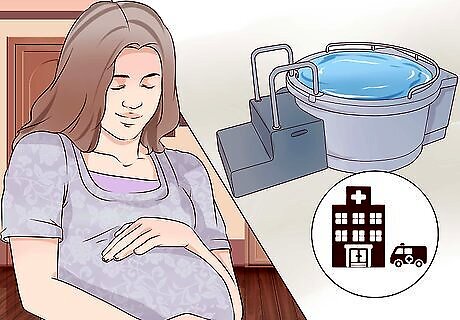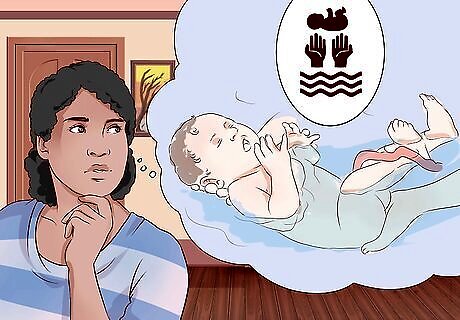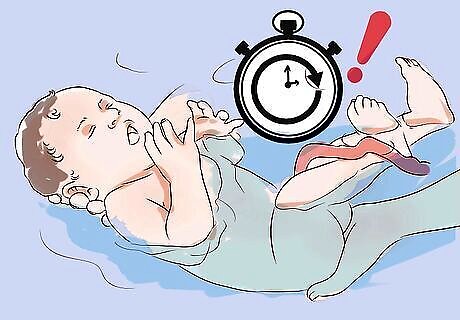
views
Learning about the Process

Know why some women choose water births. During a water birth, a baby is delivered in a birthing pool filled with lukewarm water. Deciding on a birth plan is a highly personal choice. There are a variety of reasons women choose water births over conventional methods. Know the rationale behind water births before deciding to undergo the procedure yourself. A baby spends nine months floating in an amniotic sac filled with fluids. Some women and doctors believe the transition from womb to world is easier on a child if they're submerged in water before being exposed to the open air. However, there is no research to support this and this is only an opinion. For some women, water births can be less painful. For some women, warm water can feel soothing and reduce stress during labor. Warm water has also been known to stimulate the body's release of endorphins, a feel-good hormone. Your weight is supported by water, making it easier to sit upright during delivery. This allows your pelvis to open to pass the baby during birth.

Decide if you will give birth in a hospital or at home. A water birth can be performed in a hospital setting or at home. Depending on your preference, there are special considerations for each method. Many hospitals either have policies prohibiting water births or do not have the proper resources for water births. If you want to go the hospital route, you should make sure a water birth is allowed in your chosen hospital and with your OB/GYN or midwife. The majority of water births are done at home or at birthing centers due to the inability of many hospitals to accommodate water births. If you're not in a hospital setting, you will have to rent or borrow equipment, such as a birthing pool, yourself. You will also need to hire a doula or midwife to help you through the birthing process.

Be aware of the risk factors. Certain risk factors mean you're more likely to undergo complications during birth. A water birth, especially one outside a hospital setting, may not be viable if you have any of the following conditions. Chronic, long term medical conditions like diabetes, high blood pressure, herpes, and epilepsy. Mothers who are very overweight. A history of heavy bleeding during pregnancy or birth. Premature labor. Pregnancy complications such as preeclampsia and gestational diabetes. Preterm labor, defined as going into labor two weeks before your due date.
Having a Water Birth at the Hospital

Find a hospital that allows water births. As stated, not all hospitals allow water births. Before you plan your water birth, make sure your hospital, doctor, midwife, and nurses understand your wishes and are willing to accommodate you. Talk to your doctor or midwife about your desire for a water birth. Waterbirth International, an organization that advocates for the right to water births worldwide, may be able to negotiate with your hospital. Waterbirth International also provides a directory online of hospitals and birthing centers that allow water births. You can search through their listings to find providers in your area. You should ask your doctor, midwife, and nurses all about water births and their professional opinions and experiences with the process. Any concerns you have about the process should be voiced with a medical professional before you settle on a birth plan.

Secure a birthing pool. Not all hospitals provide birthing pools. Make sure you secure access to a pool before going into labor. About half of all hospitals have birthing pools. However, even if your hospital does have a pool, this does not necessarily mean you can use it. It could be in use by another patient or need to be cleaned. It's also possible the hospital might not have water-birth experienced doctors or midwives on staff when you go into labor. In that case, you could transfer to another hospital in your area or opt to have the baby at home. Birthing pools can be rented or purchased. If you're bringing your own equipment into the hospital, you need approval beforehand. Ideally, a pool should be rented out for 4 to 6 weeks, leaving a 2 to 3 week time period before and after your due date.

Have a backup plan. As your birth progresses, certain factors may arise that mean a water birth is no longer possible. You should have an alternative birthing plan in place in the event the water birth falls through during labor. If you need to induce labor, you may not be able to undergo a water birth. It depends on your individual circumstances and the reasons for inducing labor. The medications used to induce can sometimes cause the baby stress. The baby will need to be monitored, which isn't possible during a water birth. If your baby is in the breech position, a caesarian section is needed to assure a safe delivery. A water birth will not be possible. If your blood pressure goes up, you may be asked to leave the pool. If your baby's first excrement (called meconium) is detected in the water, you may have to leave the pool to prevent meconium aspiration. If you go into preterm labor, which means going into labor more than three weeks before your due date, you will probably not be allowed to have a water birth due to the increased risk for complications for you and your baby. You should have an alternative birth plan available so, in the event of any of the above complications, you can still maintain some choice and control over your birth.
Having a Water Birth at Home

Choose a midwife. If you're going to give birth at home, you should have a trained midwife present during your labor. A variety of directories online can help you seek out midwives in your area. If you know other mothers who underwent home or water births, you can ask them where they found their midwives. Have a variety of questions ready to ask the midwife you choose. Ask them what experience they have with water births, what their specific training is, and what services they provide for you and your baby. Make sure you know your midwife's availability. Will they be able to assure availability during your birth and, if not, what would happen? Know what equipment will be provided and what equipment you should be prepared to invest in yourself. Make sure your midwife knows as much about your personal and medical history as possible. Tell them about any past pregnancies, any spiritual or religious practices that are important to you, and any concerns you have.

Select a birthing pool. If you're giving birth at home, you need to have a birthing tub present in your home. Your midwife can help you in the selection process and direct you to companies that rent out or sell birthing pools. A variety of factors should be considered when you're purchasing a birthing pool. How much space do you have for the pool? What room are you giving birth in and, if it's on an upper floor, is the floor strong enough to hold the pool's weight? Some pools have filtration and heating systems that allow you to have the pool set up before labor.

Fill up the pool and call your midwife as soon as labor starts. When you notice the early signs of labor, you need to alert your midwife and fill up your birthing pool in preparation for delivery. You should have a thermometer on hand to monitor the water's temperature. It should be between 99 and 100 degrees, but no more than 101. Your birthing partner or partners should be prepared to monitor water temperature throughout your labor. Have damp cloths on hand, as well as drinking water, to cool yourself off if you grow uncomfortably hot during labor. Make sure your hot water supply at home is adequate to fill the entire pool and have a plan as to where to dispose of the water after birth.

Be prepared for emergencies. As you're delivering at home rather than a hospital, you need to be extra prepared for potential complications during birth. Make sure you have a plan in effect for any emergencies. Know how to get out of the pool safely. It can take a while to get out of a birthing pool during labor. Have emergency contact numbers ready and do not hesitate to call 911 and request an ambulance if major complications occur. Your midwife should have equipment to monitor the baby's heartbeat and other vital signs during labor. If they notice anything concerning, they should have a plan in place, which they've gone over with you ahead of time, on how to proceed with labor. As with a hospital birth, certain complications may arise that make a water birth impossible. You should have an alternative plan in place in the event of breech births, preterm labor, increased blood pressure, and other potential birthing issues.
Knowing what to Expect

Get into an upright position. One of the supposed advantages of a water birth is that it supports your body and allows you to easily position yourself upright. This can be a more comfortable birthing position for many women as opposed to giving birth on one's back. You will sit upright during labor and the late stages of pushing during birth. The water supports your weight and allows you to more easily maneuver your body in a comfortable position. Some evidence suggests pushing the baby out is easier in water than it is in air, and the upright position increases the opening of the pelvis during birth. Many women are concerned the upright position will cause them to accidentally release their bowels. While this can occur, many women do not notice.

Know how the experience affects your baby. While we cannot know for sure how babies feel during birth, some advocates for water birth believe the experience is less traumatic. The warm waters will ideally mimic the atmosphere or your uterus, easing the intensity of the baby's transition into the world. While many worry babies will inhale water, most babies will not take their first breaths until they're lifted safely out of the water. Babies are usually only at risk of breathing underwater if their head is brought to the surface before the rest of the body is born or if there was an issue with oxygen levels in the placenta during labor.

Plan for your baby's first breath. A baby's first breath is one of the most stressful events of a water birth as mothers and doctors worry about a baby breathing underwater. However, with proper precautions and protocol your baby should take his first breath safely above the surface. A baby should be brought to the surface shortly after the final push. The baby should be submerged for no more than a few minutes. Depending on your plan, either your birth partner or your midwife/doctor will bring the baby to the surface of the water. When the umbilical cord or placenta tear, the baby is no longer supplied with oxygen. Make sure your baby is above the surface of the water before this occurs.




















Comments
0 comment